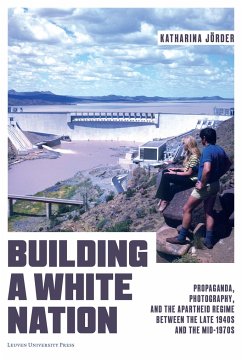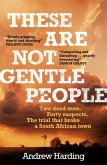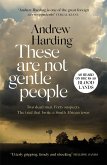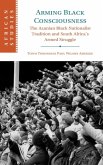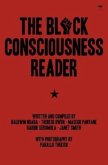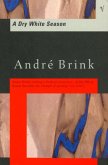Katharina Jorder
Building a White Nation
Propaganda, Photography, and the Apartheid Regime Between the Late 1940s and the Mid-1970s
Katharina Jorder
Building a White Nation
Propaganda, Photography, and the Apartheid Regime Between the Late 1940s and the Mid-1970s
- Broschiertes Buch
- Merkliste
- Auf die Merkliste
- Bewerten Bewerten
- Teilen
- Produkt teilen
- Produkterinnerung
- Produkterinnerung
A unique study of South African propaganda photography during apartheid.
Andere Kunden interessierten sich auch für
![These Are Not Gentle People These Are Not Gentle People]() Andrew HardingThese Are Not Gentle People13,99 €
Andrew HardingThese Are Not Gentle People13,99 €![These Are Not Gentle People These Are Not Gentle People]() Andrew HardingThese Are Not Gentle People20,99 €
Andrew HardingThese Are Not Gentle People20,99 €![Arming Black Consciousness Arming Black Consciousness]() Toivo Tukongeni Paul Wilson Asheeke (Georgia State University)Arming Black Consciousness117,99 €
Toivo Tukongeni Paul Wilson Asheeke (Georgia State University)Arming Black Consciousness117,99 €![The black consciousness reader The black consciousness reader]() Baldwin NdabaThe black consciousness reader23,99 €
Baldwin NdabaThe black consciousness reader23,99 €![The White Lioness The White Lioness]() Henning MankellThe White Lioness11,99 €
Henning MankellThe White Lioness11,99 €![Dry White Season Dry White Season]() Andre BrinkDry White Season9,99 €
Andre BrinkDry White Season9,99 €![Safari Nation Safari Nation]() Jacob S. T. DlaminiSafari Nation39,99 €
Jacob S. T. DlaminiSafari Nation39,99 €-
-
-
A unique study of South African propaganda photography during apartheid.
Hinweis: Dieser Artikel kann nur an eine deutsche Lieferadresse ausgeliefert werden.
Hinweis: Dieser Artikel kann nur an eine deutsche Lieferadresse ausgeliefert werden.
Produktdetails
- Produktdetails
- Verlag: Leuven University Press
- Seitenzahl: 330
- Erscheinungstermin: 30. November 2023
- Englisch
- Abmessung: 154mm x 235mm x 24mm
- Gewicht: 800g
- ISBN-13: 9789462703803
- ISBN-10: 9462703809
- Artikelnr.: 68802196
- Herstellerkennzeichnung
- Libri GmbH
- Europaallee 1
- 36244 Bad Hersfeld
- 06621 890
- Verlag: Leuven University Press
- Seitenzahl: 330
- Erscheinungstermin: 30. November 2023
- Englisch
- Abmessung: 154mm x 235mm x 24mm
- Gewicht: 800g
- ISBN-13: 9789462703803
- ISBN-10: 9462703809
- Artikelnr.: 68802196
- Herstellerkennzeichnung
- Libri GmbH
- Europaallee 1
- 36244 Bad Hersfeld
- 06621 890
Katharina Jörder is a postdoctoral researcher and lecturer of Art History at Freie Universität Berlin. Her work focuses on histories of photography, African photography, and visual culture.
ACKNOWLEDGEMENTS
NOTES ON TERMINOLOGY AND FIGURES
INTRODUCTION
White Nation-building and the Myths of Afrikaner Nationalism
Propaganda and Photography
Researching Propaganda Photography and the State of the Archives
I. SOUTH AFRICA'S INFORMATION SERVICE
I.1. The Information Service and Photography
I.2. Publications
I.3. Actors in the Propaganda Machinery
II. CELEBRATING THE WHITE NATION
II.1. The Inauguration of the Voortrekker Monument, 1949
II.2. 'We Build a Nation': The Jan van Riebeeck Festival, 1952
III. H. F. VERWOERD: 'MASTER-BUILDER' OF THE WHITE NATION
III.1. From Minister of Native Affairs to Prime Minister
III.2. The Pivotal Year 1960
III.3. The Verwoerd Couple
III.4. Statesman
III.5. Pictorial Afterlife
IV. PROPAGATING SEPARATE DEVELOPMENT
IV.1. Bantu Education
IV.2. The Health Care System
IV.3. Ernest Cole's House of Bondage, 1967
V. PERFORMING THE STATE
V.1. The Annual Openings of Parliament
V.2. The Transkei Independence Celebrations, 1976
VI. THE HENDRIK VERWOERD DAM
VI.1. Symbol of Modernity and National Pride
VI.2. The Dam in the Regime's Visual Network
CONCLUSION
NOTES
BIBLIOGRAPHY
Archival Sources
Literature
Periodicals and Newspapers
Film
Online Sources
Email Communication and Interviews
ILLUSTRATION CREDITS
NOTES ON TERMINOLOGY AND FIGURES
INTRODUCTION
White Nation-building and the Myths of Afrikaner Nationalism
Propaganda and Photography
Researching Propaganda Photography and the State of the Archives
I. SOUTH AFRICA'S INFORMATION SERVICE
I.1. The Information Service and Photography
I.2. Publications
I.3. Actors in the Propaganda Machinery
II. CELEBRATING THE WHITE NATION
II.1. The Inauguration of the Voortrekker Monument, 1949
II.2. 'We Build a Nation': The Jan van Riebeeck Festival, 1952
III. H. F. VERWOERD: 'MASTER-BUILDER' OF THE WHITE NATION
III.1. From Minister of Native Affairs to Prime Minister
III.2. The Pivotal Year 1960
III.3. The Verwoerd Couple
III.4. Statesman
III.5. Pictorial Afterlife
IV. PROPAGATING SEPARATE DEVELOPMENT
IV.1. Bantu Education
IV.2. The Health Care System
IV.3. Ernest Cole's House of Bondage, 1967
V. PERFORMING THE STATE
V.1. The Annual Openings of Parliament
V.2. The Transkei Independence Celebrations, 1976
VI. THE HENDRIK VERWOERD DAM
VI.1. Symbol of Modernity and National Pride
VI.2. The Dam in the Regime's Visual Network
CONCLUSION
NOTES
BIBLIOGRAPHY
Archival Sources
Literature
Periodicals and Newspapers
Film
Online Sources
Email Communication and Interviews
ILLUSTRATION CREDITS
ACKNOWLEDGEMENTS
NOTES ON TERMINOLOGY AND FIGURES
INTRODUCTION
White Nation-building and the Myths of Afrikaner Nationalism
Propaganda and Photography
Researching Propaganda Photography and the State of the Archives
I. SOUTH AFRICA'S INFORMATION SERVICE
I.1. The Information Service and Photography
I.2. Publications
I.3. Actors in the Propaganda Machinery
II. CELEBRATING THE WHITE NATION
II.1. The Inauguration of the Voortrekker Monument, 1949
II.2. 'We Build a Nation': The Jan van Riebeeck Festival, 1952
III. H. F. VERWOERD: 'MASTER-BUILDER' OF THE WHITE NATION
III.1. From Minister of Native Affairs to Prime Minister
III.2. The Pivotal Year 1960
III.3. The Verwoerd Couple
III.4. Statesman
III.5. Pictorial Afterlife
IV. PROPAGATING SEPARATE DEVELOPMENT
IV.1. Bantu Education
IV.2. The Health Care System
IV.3. Ernest Cole's House of Bondage, 1967
V. PERFORMING THE STATE
V.1. The Annual Openings of Parliament
V.2. The Transkei Independence Celebrations, 1976
VI. THE HENDRIK VERWOERD DAM
VI.1. Symbol of Modernity and National Pride
VI.2. The Dam in the Regime's Visual Network
CONCLUSION
NOTES
BIBLIOGRAPHY
Archival Sources
Literature
Periodicals and Newspapers
Film
Online Sources
Email Communication and Interviews
ILLUSTRATION CREDITS
NOTES ON TERMINOLOGY AND FIGURES
INTRODUCTION
White Nation-building and the Myths of Afrikaner Nationalism
Propaganda and Photography
Researching Propaganda Photography and the State of the Archives
I. SOUTH AFRICA'S INFORMATION SERVICE
I.1. The Information Service and Photography
I.2. Publications
I.3. Actors in the Propaganda Machinery
II. CELEBRATING THE WHITE NATION
II.1. The Inauguration of the Voortrekker Monument, 1949
II.2. 'We Build a Nation': The Jan van Riebeeck Festival, 1952
III. H. F. VERWOERD: 'MASTER-BUILDER' OF THE WHITE NATION
III.1. From Minister of Native Affairs to Prime Minister
III.2. The Pivotal Year 1960
III.3. The Verwoerd Couple
III.4. Statesman
III.5. Pictorial Afterlife
IV. PROPAGATING SEPARATE DEVELOPMENT
IV.1. Bantu Education
IV.2. The Health Care System
IV.3. Ernest Cole's House of Bondage, 1967
V. PERFORMING THE STATE
V.1. The Annual Openings of Parliament
V.2. The Transkei Independence Celebrations, 1976
VI. THE HENDRIK VERWOERD DAM
VI.1. Symbol of Modernity and National Pride
VI.2. The Dam in the Regime's Visual Network
CONCLUSION
NOTES
BIBLIOGRAPHY
Archival Sources
Literature
Periodicals and Newspapers
Film
Online Sources
Email Communication and Interviews
ILLUSTRATION CREDITS

